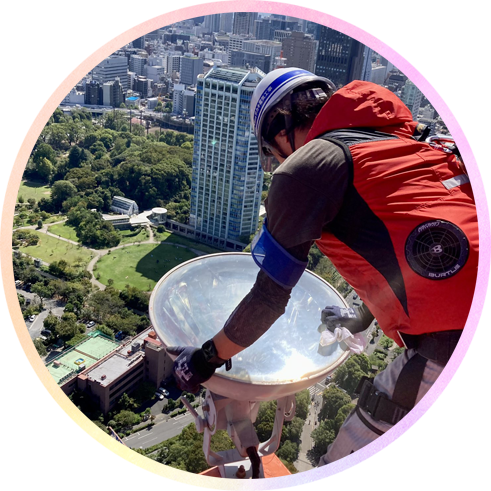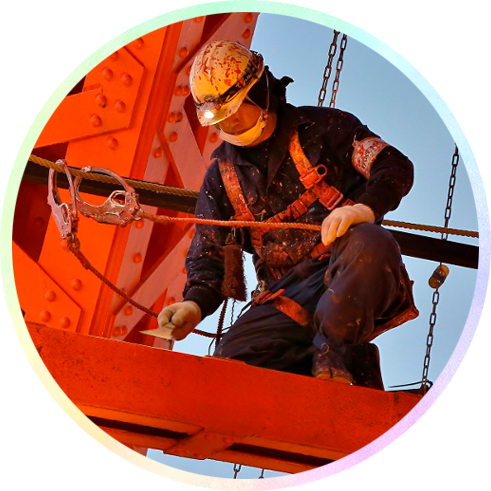Older Brother
Blue overalls

When the steel tower was to be constructed, the authorities on radio wave science were brought together and after careful consideration of each one, if radio waves were to be sent out for the Tokyo area's more than 7 VHF television stations and the UHF television stations planned to be opened in the future, with a service area of the entire Kanto district and focused around Tokyo (Mita in the north, Choshi in the east, Numazu in the south and Kofu in the west) , it was determined that the necessary height was 333 meters tall. Thus, the fact that the 333 meter tall tower was opened for business in the Showa year 33 is just a coincidence.
On the other hand, Tokyo Tower's founder Hisakichi Maeda appears to have thought, "If we're going to make it, let's make it surpass the height of the Eiffel Tower. We can accomplish it with the more advanced technology currently available."



The lighting which has been turning on since January 1, 1989 is called "Landmark Light,"and is made up of a total of 180 lights. There are two types of lighting: orange lights (high-pressure sodium lamps) in the spring, fall and winter, and silver lights (metal halide lamps) in the summer. In addition to being changed by professional labor twice every year, work is done when individual lights go out as well.
Also, the "Diamond Veil" began being lit up from December 23, 2008, and is formed by 276 lights set in the steel tower.



Approximately 21,000 yen a day on average.


Generally the lights switch off at 12 am.
There is a legend that if you see the moment the lights turn off with your lover you will become happy together, and many couples gather below around midnight to gaze up at Tokyo Tower.



The two-tone color is thought to be red and white, but actually, to be precise, the two colors are "international orange" and "white." It is decided by aviation law that buildings over a certain height must use these colors. The present Tokyo Tower's area even higher than the Main Observatory is separated into 7 equal parts, but this was 11 equal parts from when it was first built until 1986.



With a cycle of about once every 7 years, the outside paint is retouched over 1 year. Working hours are limited from sunrise until 9 o'clock, when business hours start. Excluding the antenna at the highest point, scaffolding is placed in order from the top of up to 270m of the steel tower, first lower work called scraping removal is done, and then the three stages of work of first coating, second coating and final coating are carried out. All of the painting is done by hand using brushes.


The amount of paint used for the entire 94,000㎡ painting surface is 34,0000 liters, calling on the work of about 4,200 people in all. Incidentally, if you put the paint used into oil cans (18 liter cans) and stacked them up vertically, they would reach a height 2 times taller than Tokyo Tower.



When the tower was first built, the part that is currently Top Deck was used as a work platform for antenna maintenance, but in July of 1967 it was opened to the public as an observatory. You can look down on Tokyo from a view 100 meters higher than Main Deck.



Tokyo Tower has outdoor stairs that continue from the Foot Town roof, 150 meters up to the Main Deck. They are open from 9:00 - 16:00 (9:00 - 21:00 on the way down) every day, but closed during rainy or stormy weather. There are approximately 600 steps. You may be surprised when you hear the number, but even a child in preschool can climb them in about 15 minutes.



The tower is designed with a flexible structure to match the earthquake-prone environment of Japan, so it is built to gently sway over time and gradually absorb the shock. This comes from a difference in the foundation work, and in one leg of the tower-footing foundation 10 individual shinso pillars (reinforced concrete pillars with a diameter of 2 meters) reach deep underground to Tokyo Bay sea level (20m). Even only a single leg can withstand 4,000 tons of strong pressure, and furthermore, each leg is connected underground diagonally with 20 steel rods of a diameter of 5 cm. The steel tower can withstand a wind speed of about 90m, and is designed to endure even earthquakes larger than the Great Kanto earthquake of 1923.


The most was when it swayed a maximum distance of about 90 cm during Typhoon Vera in 1959 (with a maximum instantaneous wind speed of 52 m).


The highest past records of numbers of visitors to the tower are about 5,200,000 in one year (1959), about 710,000 in one month (August, 1959) and about 40,000 in one day (March 30, 1960). As for the total up to now, the number reached 170 million people in June, 2013. In other words, all Japanese people can be calculated as having gone up to an Observatory at least over the first floor.


Because of the public nature of Tokyo Tower as an institution, we cannot make public that kind of information related to the equipment in use. We apologize for the inconvenience.


Tokyo Tower is affiliated with the "All-Japan Tower Association" (19 towers as of 2024) and the "World Federation of Great Towers" (53 towers in 25 countries as of 2024), and is part of a network uniting many famous towers throughout the world. We also periodically hold meetings, share information, and conduct joint events with our affiliates. See the links below for details!


Our official mascots are the "Noppon Brothers." They were created to mark the 40th anniversary of Tokyo Tower. You can often find them at the Tower on weekends, but they also travel around sometimes. Be sure to say hello if you see them!
The Noppon Brothers are twin boys that were created on December 23, 1998. They are, and always will be, 10 years old. They are 2 m 23 cm tall.
| Personality | Hobbies | Special skills | Dream | Favorite saying | |
|---|---|---|---|---|---|
|
Older Brother Blue overalls |
Cool, silent, and shy boy | I have no hobbies | Pranking(Kancho) | To live within his means |
Be passionate, but stay cool |
|
Younger Brother Red overalls |
Bright and cheerful, but with a lonely side too | Meeting visitors, sunbathing |
Posing, shaking hands | Become a beloved character | Start from little things diligently |
Why is Tokyo Tower 333 meters tall?